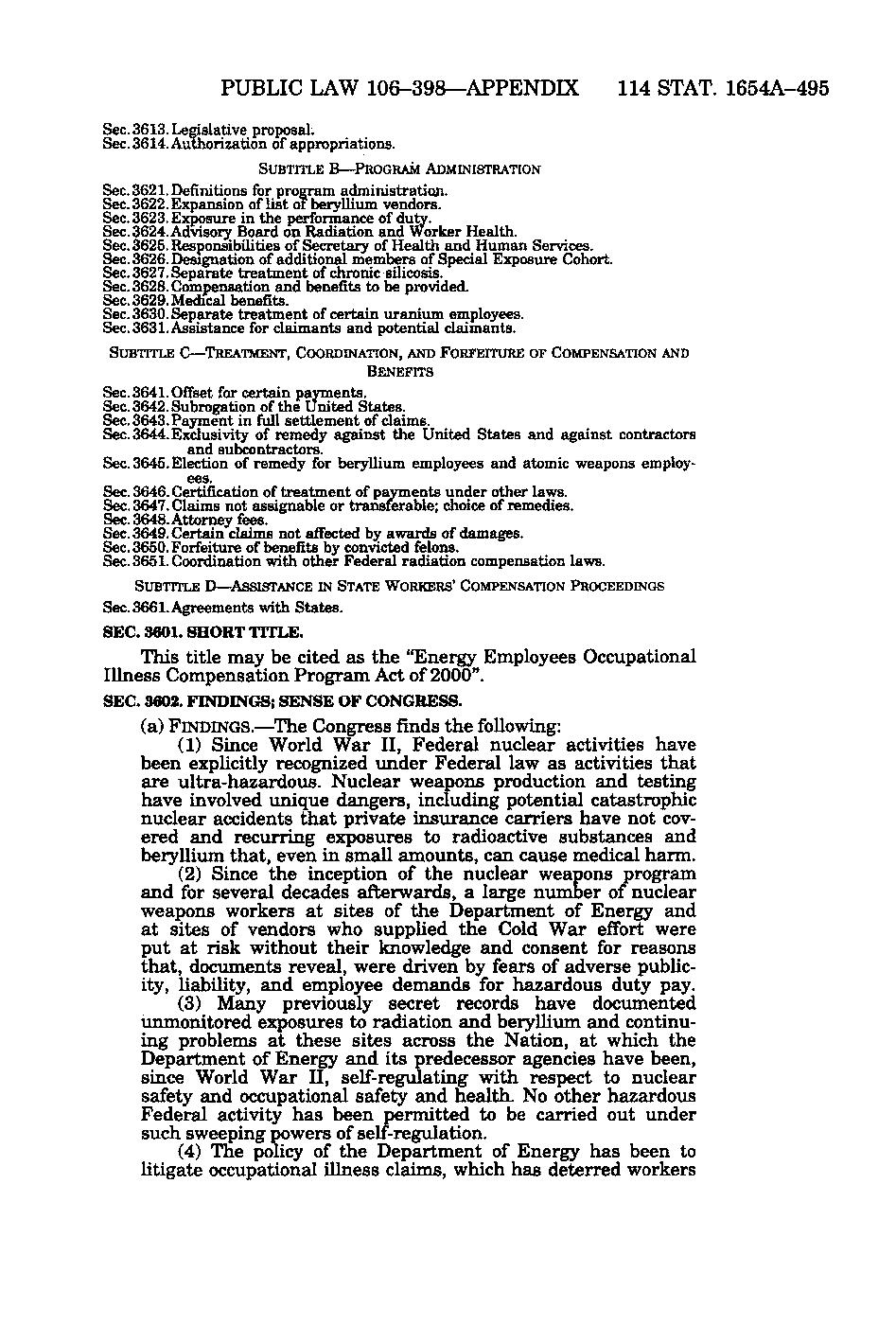PUBLIC LAW 106-398—APPENDIX 114 STAT. 1654A-495 Sec. 3613. Legislative proposal. Sec. 3614. Authorization of appropriations. SUBTITLE B—PROGRAM ADMINISTRATION Sec. 3621. Definitions for program administration. Sec. 3622. Expansion of list of beryllium vendors. Sec. 3623. Exposure in the performance of duty. Sec. 3624. Advisory Board on Radiation and Worker Health. Sec. 3625. Responsibilities of Secretary of Health and Human Services. Sec. 3626. Designation of additional members of Special Exposure Cohort. Sec. 3627. Separate treatment of chronic silicosis. Sec. 3628. Compensation and benefits to be provided. Sec. 3629. Medical benefits. Sec. 3630. Separate treatment of certain uranium employees. Sec. 3631. Assistance for claimants and potential claimants. SUBTITLE C—TREATMENT, COORDINATION, AND FORFEITURE OF COMPENSATION AND BENEFITS Sec. 3641. Offset for certain payments. Sec. 3642. Subrogation of the United States. Sec. 3643. Payment in full settlement of claims. Sec. 3644. Exclusivity of remedy against the United States and against contractors and subcontractors. Sec. 3645. Election of remedy for beryllium employees and atomic weapons employ- ees. Sec. 3646. Certification of treatment of payments under other laws. Sec. 3647. Claims not assignable or transferable; choice of remedies. Sec. 3648.Attorney fees. Sec. 3649. Certain claims not affected by awards of damages. Sec. 3650. Forfeiture of benefits by convicted felons. Sec. 3651. Coordination with other Federal radiation compensation laws. SUBTITLE D—ASSISTANCE IN STATE WORKERS' COMPENSATION PROCEEDINGS Sec. 3661. Agreements with States. SEC. 3601. SHORT TITLE. This title may be cited as the "Energy Employees Occupational Illness Compensation Program Act of 2000". SEC. 3602. FINDINGS; SENSE OF CONGRESS. (a) FINDINGS. —The Congress finds the following: (1) Since World War II, Federal nuclear activities have been explicitly recognized under Federal law as activities that are ultra-hazardous. Nuclear weapons production and testing have involved unique dangers, including potential catastrophic nuclear accidents that private insurance carriers have not covered and recurring exposures to radioactive substances and beryllium that, even in small amounts, can cause medical harm. (2) Since the inception of the nuclear weapons program and for several decades afterwards, a large number of nuclear weapons workers at sites of the Department of Energy and at sites of vendors who supplied the Cold War effort were put at risk without their knowledge and consent for reasons that, documents reveal, were driven by fears of adverse publicity, liability, and employee demands for hazardous duty pay. (3) Many previously secret records have documented unmonitored exposures to radiation and beryllium and continuing problems at these sites across the Nation, at which the Department of Energy and its predecessor agencies have been, since World War II, self-regulating with respect to nuclear safety and occupational safety and health. No other hazardous Federal activity has been permitted to be carried out under such sweeping powers of self-regulation. (4) The policy of the Department of Energy has been to litigate occupational illness claims, which has deterred workers
�
